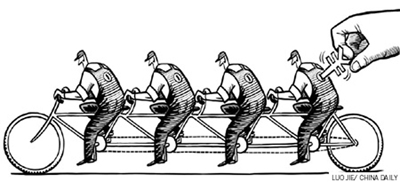 |
Large Medium Small |
|
 |
Notwithstanding all the hype over rising wages in China, it is entirely premature to declare an end to the global labor cost arbitrage that has long worked in China's favor. China remains highly competitive by international standards, and the recent round of sharp increase in wages is not likely to alter that key conclusion.
Actually, the current outbreak of increase in minimum wages is largely going according to the script of China's 2004 labor reform, which required local governments to raise minimum wages at least every other year. But circumstances changed relative to conditions prevailing at the time that reform was implemented, and the script had to be discarded - at least for a while.
In the depths of the global financial crisis in late 2008, when Chinese exports were under severe downward pressure, the government ordered a deferral of scheduled increases in minimum wages in an effort to combat mounting recessionary risks.
But now, in the face of a more stable global climate and impressive resilience in the Chinese economy, that emergency policy is being relaxed. In that important respect, recent increases in minimum wages should be seen as a catch-up from previously slated hikes that had been foregone during the crisis.
The data on international wage comparisons, too, do not point to dramatic deterioration in China's wage advantage. According to research published in the Monthly Labor Review of the US Bureau of Labor Statistics in April 2009, compensation of Chinese manufacturing workers was only $0.81 per hour in 2006 - just 2.7 percent of comparable costs in the US, 3.4 percent of that in Japan, and 2.2 percent of compensation rates in Europe.
While these figures are now out of date by nearly four years, they underscore the magnitude of the gap between China and the developed world - and how difficult it would be to close that gap even under the most excessive of Chinese wage inflation scenarios.
For example, if Chinese manufacturing wages had increased at an average annual rate of 25 percent during the 2007-10 period - which is highly unlikely for reasons noted below - the hourly compensation rate would be just $1.98 in 2010. That would boost Chinese compensation to only about 4 percent of US pay rates - barely making a dent in narrowing the arbitrage with major industrial economies. A similar comparison would be evident with other countries in the developing world. At $1.98 per hour in 2010, Chinese hourly compensation in manufacturing would still be less than 15 percent of that elsewhere in East Asia (ex Japan) and only about half the pay rate in Mexico.
It is important to stress that this 25 percent hypothetical wage-inflation scenario is well beyond the outer bound of any conceivable outcome for China. While minimum wage gains in some provinces may well be rising at such a clip this year, there is good reason to believe that between one-third and one-half of all Chinese manufacturing employees are currently paid above the minimum wage.
Inasmuch as higher paid workers would be largely unaffected by recent actions, total wage increases would be considerably less than those accruing to the low end of the Chinese pay-scale.
At the same time, it is equally important to assess increases in Chinese labor compensation in the context of rapidly rising worker productivity. Based on data from the World Bank, annualized productivity growth in the Chinese manufacturing sector appears to have been running in the 10 percent to 15 percent range since 1990 - not all that dissimilar from gains in real hourly compensation. That would imply only marginal upward pressure on unit labor costs, suggesting little underlying deterioration in Chinese competitiveness.
Moreover, the impact of rising wage pressures also needs to be judged in the context of other dimensions of China's competitive advantage, namely, scale, infrastructure, pan-Asian supply-chain logistics, and the relatively recent installation of state-of-the-art production technologies. China has lost little, or none, of the edge in those critically important areas.
Finally, it is important to note that increasing worker compensation is a key ingredient of China's pro-consumption growth strategy. A serious shortfall in the growth of consumer purchasing power remains a critical problem for an unbalanced Chinese economy. Personal income currently amounts to just 40 percent of Chinese GDP - decidedly sub-par by international standards and down over 10 percentage points from the 51 percent reading in 2000. That needs to change if China is ever going to come to grips with its rebalancing imperatives.
Yet that could well be the real silver lining to this story. To the extent that compensation increases now outstrip the growth in GDP, the labor income share will begin to rise. That sets the stage for increases in household purchasing power, which are critical for pushing China's consumption share of its GDP up from the rock-bottom 36 percent reading in 2009.
Rather than bemoaning the end of low Chinese labor costs, the global debate should focus more on the constructive implications of this important development for the long-awaited pro-consumption rebalancing of the Chinese economy.
The author is non-executive chairman of Morgan Stanley Asia and a member of the faculty of Yale University. He has the book, The Next Asia, to his credit.